Smart Homes, Buildings (Energy Efficient, Automated) Market
P
2022
Smart Homes, Buildings (Energy Efficient, Automated) Market Size, Share, Competitive Landscape and Trend Analysis Report, by Application, by Technology, by End Use : Global Opportunity Analysis and Industry Forecast, 2020-2030
Smart Homes, Buildings (Energy Efficient, Automated) Market Research, 2030
The global smart homes, buildings (energy efficient, automated) market size was valued at $32.0 billion in 2020, and is projected to reach $78.2 billion by 2030, growing at a CAGR of 9.4% from 2021 to 2030.
A smart home refers to a convenient home setup where appliances and devices can be automatically controlled remotely from anywhere with an internet connection using a mobile or other networked device. Devices in a smart home are interconnected through the internet, allowing users to control functions such as security access to home, temperature, lighting, and a home theater remotely. Smart home devices are connected with each other and can be accessed through one central point—a smartphone, tablet, laptop, or game console. Door locks, televisions, thermostats, home monitors, cameras, lights, and even appliances such as refrigerators can be controlled through one home automation system. The system is installed on a mobile or other networked devices and users can create time schedules for certain changes to take effect. Smart homes can feature either wireless or hardwired systems—or both. Wireless systems are easier to install. Putting in a wireless home automation system with features such as smart lighting, climate control, and security can cost several thousand dollars, making it very cost-friendly. Hardwired systems, on the other hand, are considered more reliable and are typically more difficult to hack. A hardwired system can increase the resale value of a home. However, there is a drawback—it is fairly expensive. Installing a luxury and hardwired smart system can cost homeowners tens of thousands of dollars.
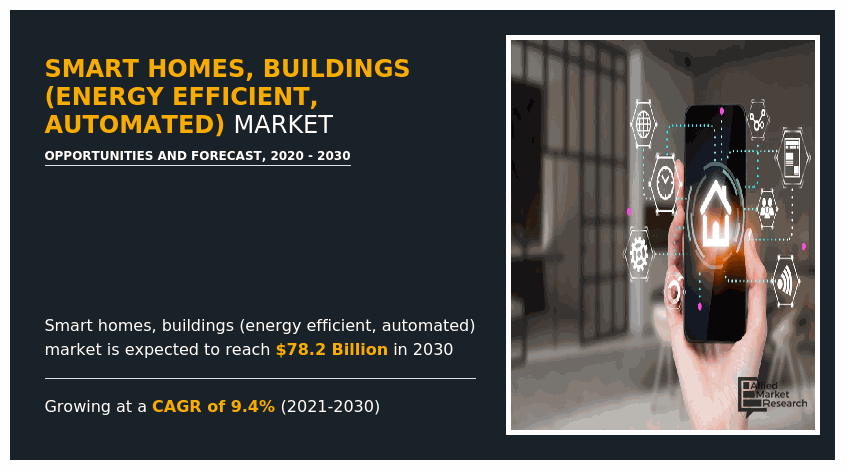
In addition, rise in artificial intelligence and machine learning technology across the globe led to increase in sales of smart gadgets, which increases the scope of smart homes and acts as a factor for the market growth. Moreover, smart homes decrease physical work of human being, which increase laziness and fatigue, which leads to rise in diseases and acts as a major restraining factor for the market.
The global smart homes, buildings (energy efficient, automated) market industry is segmented on the basis of application, technology, end use, and region. By application, it is classified as energy management, lighting control, HVAC, safety & security, home healthcare, and child safety. By technology, it is categorized into Bluetooth, Zigbee, RFID, and Wi-Fi. By end use, it is categorized into residential, commercial, and others. Region wise, the market is analyzed across North America, Europe, Asia-Pacific, and LAMEA.
Key players profiled in smart building, homes include Cisco Systems, Inc., Control4 Corporation, Leviton MFG. Company Inc., Schneider Electric SA, Siemens Building Technologies, United Technologies Corporation, Honeywell Scanning & Mobility, Smarthome, Inc., Emerson Electric Co., and LG Electronics Inc.
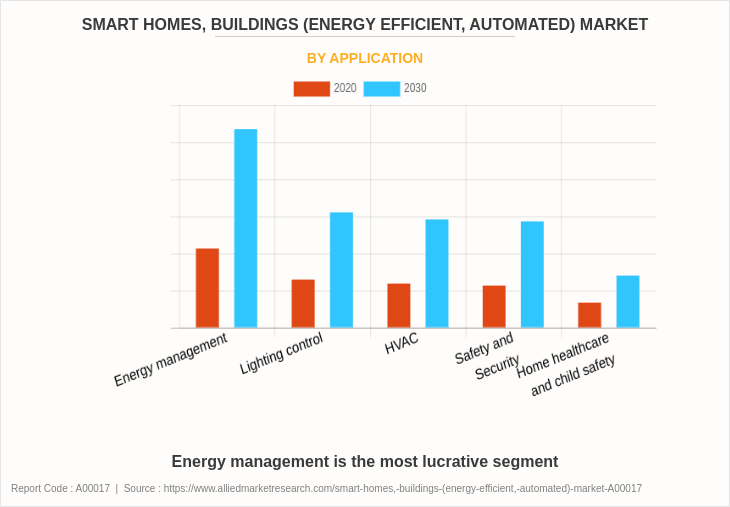
By application, the energy management segment dominated the market in 2020, and is projected to remain the fastest-growing segment during the forecast period. This is attributed to rise in competition in the market.
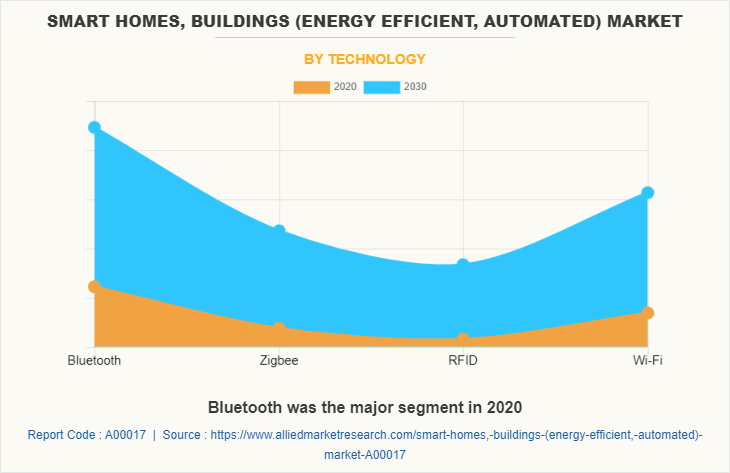
By technology, the bluetooth segment dominated the market in 2020, and is projected to remain the fastest-growing segment during the forecast period. This is attributed to rise in urbanization & industrialization and growing dependency on Wi-Fi for every gadget.
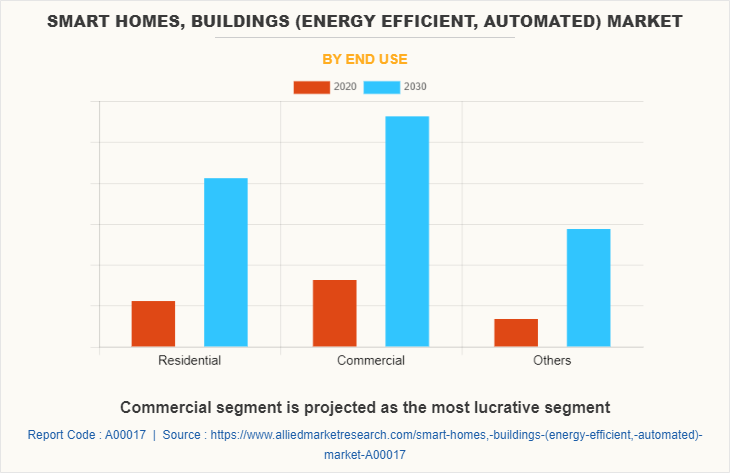
By end-use, the commercial segment dominated the market in 2020, and is projected to remain the fastest-growing segment during the forecast period. This is attributed to expansion of technology and increase in comfort level of human being across the globe.
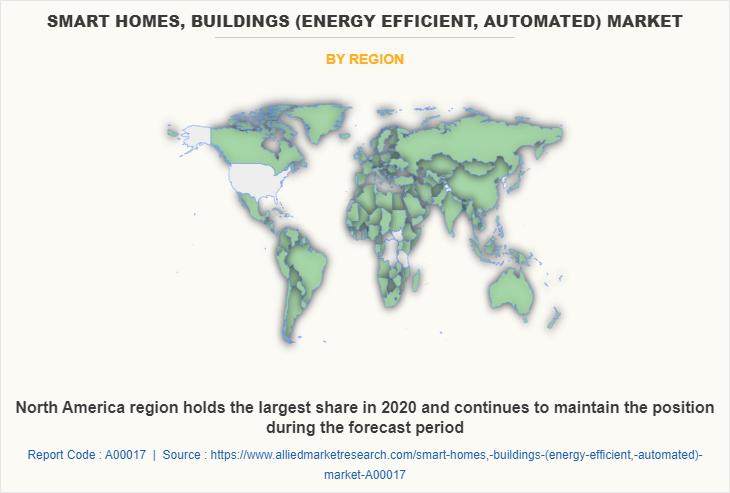
By region, North America dominated the global smart homes, buildings (energy efficient, automated) market in 2020, and is projected to remain the fastest-growing segment during the forecast period. This is attributed to large population and rapid urbanization and government projects such as smart cities in the region.
Sales of smart homes, buildings (energy efficient, automated) gadgets is directly proportional to the sales of electronic gadgets. Disrupted import & export activities led to decline in production of such gadgets, which, in turn, led to decline in growth of the smart homes, buildings (energy efficient, automated) market.
IMPACT OF COVID-19 ON THE GLOBAL SMART HOMES, BUILDINGS (ENERGY EFFICIENT, AUTOMATED) MARKET
- The COVID-19 pandemic has had a significant impact on the construction sector. COVID-19 outbreak have severely disrupted the economy, with devastating effects on global trade and it has simultaneously affected households, businesses, financial institution, industrial establishments, and infrastructure companies. The economic crisis caused by the virus has hit many organizations around the world. Similarly, construction and engineering projects around the world have been jeopardized in various ways by the COVID-19 pandemic and many projects have been closed. As a result, there has been a financial recession in the construction industry in almost all countries and has created unemployment. This situation has caused great concern, uncertainty, and unrest in the construction industry. In addition, the smart homes & buildings sector is a segregated part of construction, however, negative impact on construction shows negative result on smart homes, buildings (energy efficient, automated) market.
- Sales of smart homes, buildings (energy efficient, automated) gadgets is directly proportional to the sales of electronic gadgets. Disrupted import & export activities led to decline in production of such gadgets, which, in turn, led to decline in growth of the smart homes, buildings (energy efficient, automated) market.
- COVID-19 impacted almost all industries by hindering various industrial operations and disrupting the supply chain. Maximum companies halted their operations due to less workforce. However, there is a sluggish decline in the global smart homes, buildings (energy efficient, automated) market, owing to impact of the COVID-19.
- Furthermore, import and export activities were significantly impacted, which, in turn, adversely affected the industries using smart homes, buildings (energy efficient, automated) and thereby affecting the market.
- According to the United Nations Industrial Development Organization (UNIDO), 30.0%–70.0% of pre-COVID-19 workforce of various industries, such as electrical and other third-party vendors migrated to their hometowns, owing to uncertainties and loss of income during the lockdown. This unavailability or less availability of workforce is expected to directly affect production and manufacturing activities, thereby resulting in decline in manufacturing, electrical and construction industry, which leads to decline in growth of the smart homes, buildings (energy efficient, automated) market. during the forecast period.
Key Benefits For Stakeholders
- This report provides a quantitative analysis of the market segments, current trends, estimations, and dynamics of the smart homes, buildings (energy efficient, automated) market analysis from 2020 to 2030 to identify the prevailing smart homes, buildings (energy efficient, automated) market opportunities.
- The market research is offered along with information related to key drivers, restraints, and opportunities.
- Porter's five forces analysis highlights the potency of buyers and suppliers to enable stakeholders make profit-oriented business decisions and strengthen their supplier-buyer network.
- In-depth analysis of the smart homes, buildings (energy efficient, automated) market segmentation assists to determine the prevailing market opportunities.
- Major countries in each region are mapped according to their revenue contribution to the global market.
- Market player positioning facilitates benchmarking and provides a clear understanding of the present position of the market players.
- The report includes the analysis of the regional as well as global smart homes, buildings (energy efficient, automated) market growth, key players, market segments, application areas, and market growth strategies.
Smart Homes, Buildings (Energy Efficient, Automated) Market Report Highlights
| Aspect | Details |
|---|---|
By Application |
|
By Technology |
|
By End Use |
|
By Region |
|
Key Market Players | United Technologies Corporation, Control4 Corporation, Honeywell Scanning & Mobility, Emerson Electric Co., Schneider Electric SA, LG Electronics Inc, Cisco Systems, Inc., Siemens Building Technologies, Leviton MFG. Company Inc., Smarthome, Inc. |
Analyst Review
The smart homes, buildings (energy efficient, automated) market holds a substantial scope for growth globally. Its contribution to the global market would increase significantly within the span of next ten years. Recent discoveries and innovations have created vast opportunities for numerous players to step in the smart homes, buildings (energy efficient, automated) market.
According to perspectives of CXOs of leading companies, surge in demand for smart gadgets, especially smart phones, tablets, lights, fans, LED TV, and other related smart appliances boosts growth of the market. Moreover, increase in demand from developing countries, such as China and India, owing to rapid urbanization and growth in government projects such as smart cities drive the market growth.
Furthermore, CXOs are optimistic regarding adoption of smart homes, buildings (energy efficient, automated) appliances in residential apartments and commercial complexes. As per CXOs, Asia-Pacific occupies large share of the global smart homes, buildings (energy efficient, automated) market. In addition, the smart homes, buildings (energy efficient, automated) market in Europe is expected to grow at a rapid rate in the future.
Related Tags
Energy Savings Green Buildings Home Energy management Smart EnergyFrequently Asked Questions?
Agreement, business expansion and product launch are the key growth strategy of Smart Homes, Buildings Market players
North America will provide more business opportunities for global Smart Homes, Buildings Market in future
Time and energy saving feature of smart homes & buildings and rising artificial intelligence & machine learning technology across the globe led to increase the sale of smart gadgets which in turn to increase the scope of smart home which may act as the major driving factor the market. In addition, rising
Bluetooth segment holds the maximum share of the Smart Homes, Buildings Market.
Cisco Systems, Inc., Control4 Corporation, Leviton MFG. Company Inc., Schneider Electric SA, Siemens Building Technologies, United Technologies Corporation, Honeywell Scanning & Mobility, Smart home, Inc., Emerson Electric Co. and LG Electronics Inc are the leading market players active in the Smart Homes, Buildings market.

